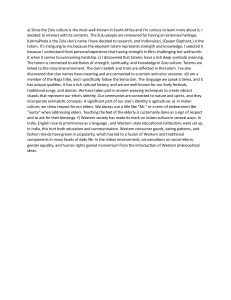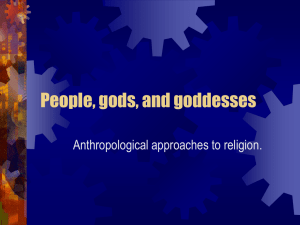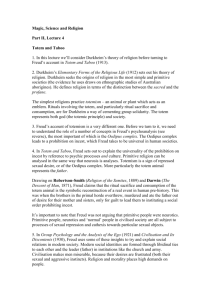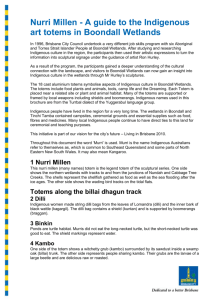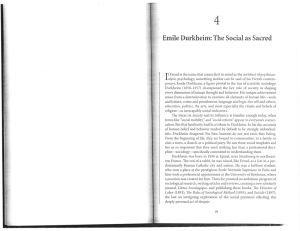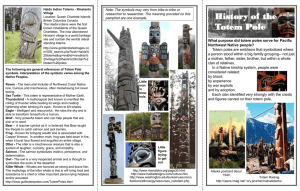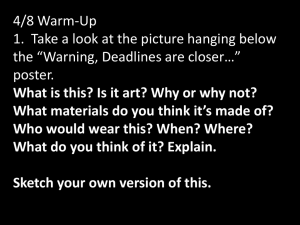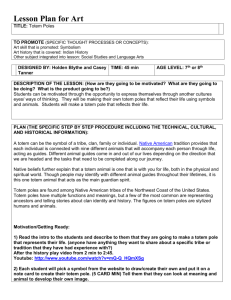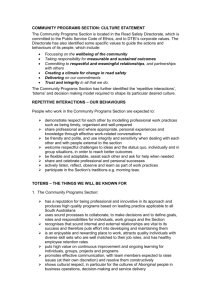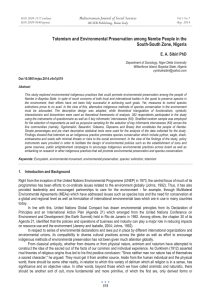1 Notes on Totemism Source: Emile Durkheim , The Elementary
advertisement
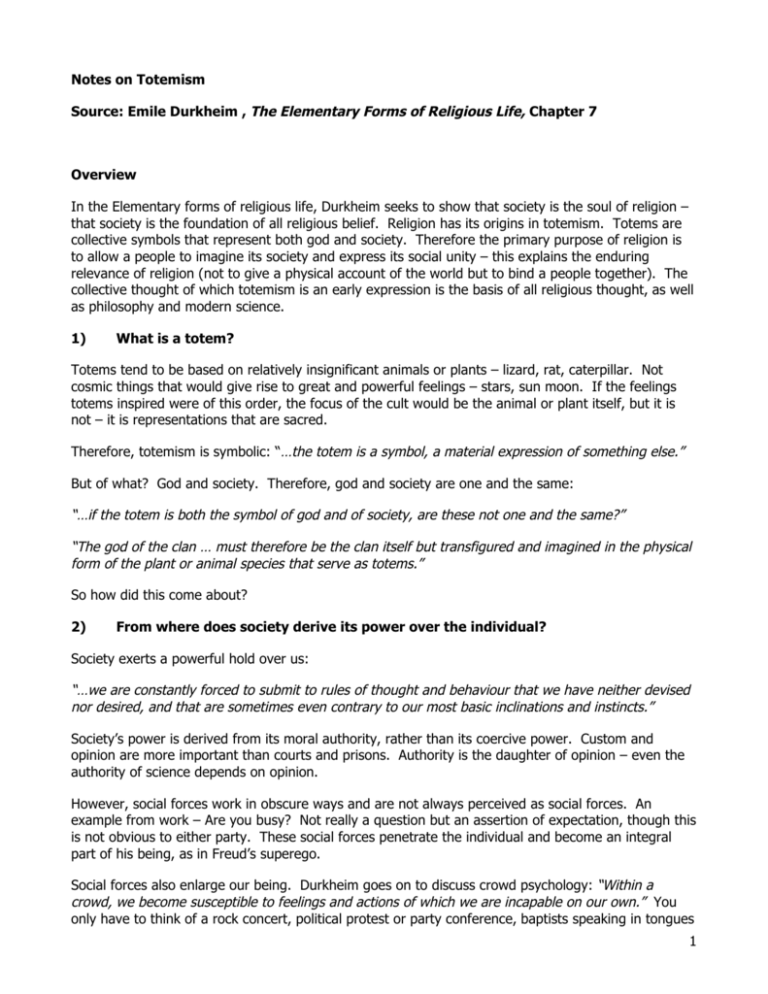
Notes on Totemism Source: Emile Durkheim , The Elementary Forms of Religious Life, Chapter 7 Overview In the Elementary forms of religious life, Durkheim seeks to show that society is the soul of religion – that society is the foundation of all religious belief. Religion has its origins in totemism. Totems are collective symbols that represent both god and society. Therefore the primary purpose of religion is to allow a people to imagine its society and express its social unity – this explains the enduring relevance of religion (not to give a physical account of the world but to bind a people together). The collective thought of which totemism is an early expression is the basis of all religious thought, as well as philosophy and modern science. 1) What is a totem? Totems tend to be based on relatively insignificant animals or plants – lizard, rat, caterpillar. Not cosmic things that would give rise to great and powerful feelings – stars, sun moon. If the feelings totems inspired were of this order, the focus of the cult would be the animal or plant itself, but it is not – it is representations that are sacred. Therefore, totemism is symbolic: “…the totem is a symbol, a material expression of something else.” But of what? God and society. Therefore, god and society are one and the same: “…if the totem is both the symbol of god and of society, are these not one and the same?” “The god of the clan … must therefore be the clan itself but transfigured and imagined in the physical form of the plant or animal species that serve as totems.” So how did this come about? 2) From where does society derive its power over the individual? Society exerts a powerful hold over us: “…we are constantly forced to submit to rules of thought and behaviour that we have neither devised nor desired, and that are sometimes even contrary to our most basic inclinations and instincts.” Society’s power is derived from its moral authority, rather than its coercive power. Custom and opinion are more important than courts and prisons. Authority is the daughter of opinion – even the authority of science depends on opinion. However, social forces work in obscure ways and are not always perceived as social forces. An example from work – Are you busy? Not really a question but an assertion of expectation, though this is not obvious to either party. These social forces penetrate the individual and become an integral part of his being, as in Freud’s superego. Social forces also enlarge our being. Durkheim goes on to discuss crowd psychology: “Within a crowd, we become susceptible to feelings and actions of which we are incapable on our own.” You only have to think of a rock concert, political protest or party conference, baptists speaking in tongues 1 and laying on hands or Hitler at Nuremburg to see that this is the case. Public meetings are essential to keeping social sentiments alive. These social forces (opinion and collective activity) create moral consciousness. Because social forces work in obscure ways and because they are largely beyond our control (language, customs, opinions), moral consciousness is experienced as if it was divinely invested – i.e. as if it was the product of external agency and was not socially contingent. However, moral consciousness is invested by society. “This is moral consciousness, which the ordinary man has never distinctly imagined for himself except with the aid of religious symbols.” “He could not escape the feeling that outside him there are powerful causes which are the source of his characteristic nature, benevolent powers that aid him, and assure him a privileged fate. And he necessarily granted those powers a dignity comparable to the great value of the benefits he attributed to them.” Durkheim then shows how the two primary influences on man, the empirical/physical and the collective/social, result in him splitting the world into two distinct categories – sacred and profane. The experience of these two external pressures, one tangible and one intangible, create two different orders of experience. The physical world inspires no special respect (profane), while the social world inspires veneration (sacred). Discussion of Australian societies and the corroboree – religious festivals at which all social conventions are flouted. Tribe gets together. Men and women, initiates and uninitiated take part. Religious effervescence: boomerangs are banged together, bull roarers are whirled, rules on exogamy are breached. This derangement of the senses contrasts sharply with the daily life and the festivals give their participants a sharper sense of the sacred and profane worlds, as both are fully realised. This effervescence is the basis of religious feeling. 3) How does social authority become embodied in a totem? Totems are the clan’s flag. The religious feelings inspired by society are therefore projected onto the totem. “The totem is the clan’s flag. It is therefore natural that the feelings the clan awakens in individual consciousness … are much more attached to the totem than to the clan. The clan is too complex a reality for such rudimentary minds to picture clearly its concrete unity.” (There’s the inevitable chicken and egg problem here. Which came first, religious thought or the totem? How can you have a totem without religious thought? Durkheim remains silent.) The totem becomes the image of the clan and, psychologically, takes priority over it – a complex reality is represented in simple form. Same with national flags, or wearing black when in mourning. Complex entities simply represented. 4) The nature and validity of religion “First in the world, fear created the gods.” Durkheim refutes this – the gods were firstly friends, relations and protectors. 2 Religion arose from society and man responds to society spontaneously and without resistance. His relationship with society is not experienced as yielding to coercion but responding to his inner nature. Durkheim also refutes naturalist and animist views of religion, e.g. Frazer’s naturalist view of religion as a response to the cyclical nature of the seasons. Man did not create religion from observation of the physical world. “From the tangible, we can only make the tangible.” Religion is not illusory, it is not a hallucination, it is rooted in social reality. Why does religion endure? Why do millions of people around the world adhere to the beliefs of Palestinian pastoralists who lived two thousand years ago? Because its primary role is not to describe the nature of the physical world but to enable us to imagine and represent our own society. Religious acts are not futile. “God is merely the symbolic expression of society.” This is why militant atheists like Dawkins and Dennett have got religion wrong. They see religions as theories about the origins and functioning of the world that are thoroughly superseded by modern physics and biology. They show no understanding of religion as a set of practices which give meaning to people’s lives by rooting them in a particular culture and giving them a sense of their collective being. 5) Why represent the clan through a totem and why choose a totem from the world of animals and plants? We have seen how social authority impresses itself on the individual, how social authority acquires a religious dimension and how religious feelings are expressed in totems. But why are totems consistently borrowed from the animal and plant worlds? Symbolism is necessary to collective life. An emblem is a convenient and necessary shorthand for expressing social unity. Without symbolism, social feelings could not last long and would only have a precarious existence. “Social life, then, in every aspect and throughout its history, is only possible thanks to a vast body of symbolism.” Groups often express their solidarity through marking their bodies (sailors’ tattoos, early Christians would mark themselves with a cross). The purpose of this, as with totems, is not to evoke the object but to bear witness to a shared moral life. These emblems should be close and familiar (the sailor’s anchor tattoo) and should be capable of representation. Therefore, clans would take the essential elements of the natural world and of economic life as their totems. 6) Collective thought as the basis of all religion, philosophy and science Collective thought, through totemism and religious expression enabled humans to step into a world beyond mere sensory impressions, a conceptual world of hidden correspondences. This allowed them to make internal connections between disparate things (e.g. associating a man with a kangaroo) and find hidden causes for things that previously remained invisible. “The crucial thing was not to let the mind submit to appearances but, on the contrary, to teach it to dominate them and bring together what the senses would keep apart.” (Without contraries is no progression.) 3 “To say that a man is a kangaroo, that the sun is a bird, is this not identifying one thing with another? But we do not think any differently when we say that heat is movement, that light is a vibration in the ether, and so on. Every time we yoke together heterogeneous terms by an internal bond, we are of necessity identifying contraries.” The genesis of this mode of thinking, which informs all philosophy and science, depends on collective thought, which allowed us to enter into a conceptual realm independent of sense perception. 4
